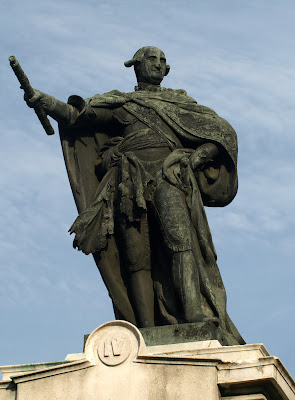Intramuros is a Latin word that means “within the walls.”
Within these walls, lays remnants of time, preserved or ruined. The paved streets, the heritage churches and houses, the bastions and the puertas (entrances on the walls), Philippines own “Walled City
But besides the walls, the churches, the houses, and all the heritage establishments, there are the silent observers, standing proud and erect among us. They are the monuments, sculptured in the likeness of their human models. They tell their stories.
There are some 20 monuments inside Intramuros. Some date back to the Spanish regime. Others were built in the early 19th century when we were a colony of the United States
Test of time
The more prominent monuments are those dating back from the 18th century that stood the test of time and uphold the beauty of renaissance art.
Carlos IV Monument (1808)
A monument gilded by the goldsmiths of Santa Cruz
Anda Monument (1871)
Located in the Anda Circle Bonifacio Drive Fort Santiago
Legazpi-Urdaneta Monument (1891)
The conqueror of the Philippine archipelago and first Governor General of the Philippines Manila
Queen Isabel II Monument (1860)
The most traveled monument. The statue was unveiled at Arroceros now Liwasang Bonifacio in 1860, then it was transferred to Malate Church
Benavides Monument (1891)
A monument made in Paris by Tony Noel in 1889 and inaugurated in 1891 in the Philippines University of Santo Tomas
In memoriam
These monuments mark certain events in Philippine history. They remind us of the lives lost in war, tragedies, etc.
Memorare-Manila 1945 Monument
The monument serves as memorial to the hundred-thousands lives of Filipino men, women and children that perished during the World War II Battle in Manila
Squadron 201 Monument
Squadron 201, was a group of fighter planes from the Mexican Air Force, that joined the Laging Handa Monument
A monument created by the Colegio de San Juan de Letran to remember the three Letran Boy Scouts who died in a plane crash on July 1963 on their way to the Eleventh World Jamboree. A total of 24 boy scouts perished and a monument representing all 24 is in Filipino heroes
Monument to Filipino icons Ninoy and Cory Aquino
The first monument to commemorate late President Corazon “Cory” Aquino stands beside her martyred husband’s—late Sen. Benigno “Ninoy” Aquino Jr.—monument. The Cory monument is sculpted by the same man who sculpted the first Ninoy monument in Tarlac, Ed Castrillo. Originally, the Cory monument had straight hair, but her son, who was to become President Benigno Aquino 3rd made a comment to Castrillo that his “mom had curly hair.”President Diosdado Macapagal
Gat Antonio de Jesus Villegas
Gat Andres Bonifacio, Gat Antonio de Jesus Villegas and President Diosdado Macapagal monuments
All three monuments are located inside the Pamantasan ng Lungsod ng Maynila.Gat Andres Bonifacio, Gat Antonio de Jesus Villegas and President Diosdado Macapagal monuments
The monument was inaugurated March 9, 1991 at the Lyceum of the Philippines
Others
Monument of King Philip II
It is a bronze statue erected in honor of Philip II, King of Spain, during the centennial celebration of the independence of the Philippines in 1998. The statue was unveiled by the Spanish monarch Queen Sophia.















ALEXIS MAESTRE-SABORIT(42)SUFRE TODA CLASE DE ATROPELLOS EN LOS ESTADOS UNIDOS DE AMERICA, ES CRUELMENTE DISCRIMADO Y SUJETOS SIN ESCRUPULOS LE LANZAN PIEDRAS A SU HUMILDE HOGAR, DONDE VIVE CON SU QUERIDA MADRE ENFERMA, TODO ESTO, PORQUE EL NO PIENSA IGUAL QUE LA BURGUESIA CAPITALISTA YANQUIS, ADEMAS POR SER INDIO E HISPANO, SI ALGUNA FATALIDAD LE OCURRE ES PLENA RESPONSABILIDAD DEL IMPERIALISMO YANQUIS.
ReplyDeleteDIOS BENDIGA AL HUMILDE Y POBRE INMIGRANTE ALEXIS MAESTRE-SABORIT.
ALEXIS MAESTRE-SABORIT(42) UNA VICTIMA DEL IMPERIALISMO YANQUIS.
ReplyDeleteSU CASA HUMILDE EN FORT MYERS, ES APEDREADA POR NEGROS LACAYOS AL SERVICIO IMPERIAL, POR LEER EL CORAN, Y POR SU LUCHA CONTRA LAS INJUSTICIAS EN ESTADOS UNIDOS.
PESE A QUE VIVE CON SU MADRE ANCIANA Y ENFERMA, LOS IMPERIALISTAS YANQUIS CONTINUAN DIA A DIA ABUSANDO DE ESTE NOBLE Y HUMILDE INMIGRANTE.